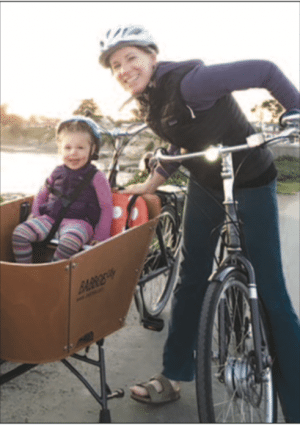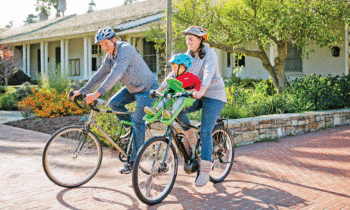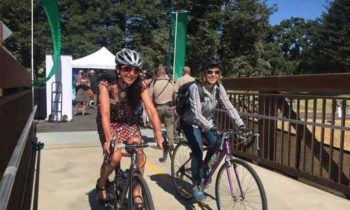June 19, 1997
San Jose Mercury News
By KAREN KEFAUVER
I will not cross the finish line last at the Women’s Danskin Triathlon this Sunday. No matter how slowly I swim, bike and run, Sally Edwards will be behind me and everyone else, determined to bring up the rear at Lake Almaden. That is part of her job.
Edwards, spokeswoman for the six-race Danskin series, will trail the slowest competitor throughout the half-mile swim, 20 kilometer-bike ride and 5-kilometer run. “I’m called the ‘sweep athlete,'” explains the 13-time Ironman finisher.
I find this comforting since I am entering my first triathlon.
Race director Diane Lydon estimates that Edwards and I will be among 1,400 women at the triathlon, part of an 8-year-old national series designed for amateur athletes. Like me, many women will be trying the sport for the first time.
I began to envision myself as a triathlon contender last summer when I cheered my friends from the sidelines at their races. I realized that I, too, might proudly cross the finish line purple-faced and sweat-drenched, supported by friends and family.
But how could I tackle a combined swim, bike and run? I rarely swam; I didn’t even like to put my face in the water. The thought of the crawl reminded me of nearly drowning during a 6th grade swim meet. I felt wobbly on skinny tires and perplexed by multiple gears of my road bike. Sprinting for a school bus was the only running experience I had.
I knew I needed some help to prepare for a triathlon.
For the past two months, I have been training twice a week with 18 other women in Terry Schneider’s “Give it a Tri” Women’s Clinic in Santa Cruz County. A professional triathlete, Terry has been coaching our group workouts and assigning us individual training programs. She has taught us race jargon, demystified our gear, and has provided insider tips.
A certified fitness specialist, Terry, 35, has competed at the World Class Triathlon level for almost a decade. She has three top 5 placings in the Hawaii Ironman Triathlon World Championships; has competed in the ESPN X Games Adventure Race, and is heading to Australia this summer for her third Eco Challenge, an eight day adventure race.
“When I started doing triathlon, there was no one to help,” says Terry. “I groveled my way through.” When she is not globetrotting to various endurance events, the Santa Cruz native shares her wealth of knowledge through training clinics for women with different levels of experience. Women in particular, she believes, benefit from the sport; “It really helps with body confidence.”
Our clinic’s first meeting was a potluck dinner at Terry’s Aptos home, (perhaps the only house in the neighborhood with two kayaks lashed to its front). I soon discovered that most of the women in “Give it a Tri” had never attempted a triathlon.
Many of us shared similar apprehensions: Karen Lippe, 36, of San Jose, expects the swim to be the most difficult because her “favorite stroke is dog paddle;” Nancy Alsip, 27, a new mother and an aerobics instructor at Scotts Valley Fitness Club, guesses that completing the triathlon may be as tough as giving birth; Fern Van Sant, 44, a Santa Cruz parrot veterinarian fears running; Sharon Patin, 37, a Mountain View copywriter and self-described workaholic, says that although she doesn’t run, bike or swim she seeks a “personal adventure;” Shannon Springmeyer, 26, a Santa Clara County firefighter, wants to rekindle her sense of challenge, and Sherbeam Wright, 27, of San Jose, says her goal is not to come in last.
Together, our band of “Tris in Training” has tackled an open water swim by the Cement Ship at Seacliff Beach; cycled the hills in Aptos; trotted around the Soquel High School track; and jogged through the trails at Nisene Marks. We have even completed a tough combined bike-run workout (commonly called a “brick”) at the Rio Del Mar Beach.
Terry has blocked out each hour and a half training session as a combination of lecture and workout. Gradually, she’s guided us towards more demanding group and personal workouts, suggesting that we learn a good pace by practicing putting in 70, then 80, then up to 100 percent effort at a bike or run for a set period of time.
My least favorite training was the hour in the pool. Terry had us put aside all the “toys” (flippers, hand paddles, kick boards) and do four sets of hundreds (16 laps) of only crawl. “You’ll work up to 2,000 yards,” she told us. I would rather push myself on a hilly two-hour bike ride any day than flounder in the water.
A few weeks ago, we all clustered in the deep end of the swimming pool, a mass of begoggled and bathing-capped competitors, to simulate a mass start. Arms flailing, feet kicking, heads bobbing for breath, we did three trial laps around the well — it was terrifying. “It’s much worse than this,” assured Julie Small of San Jose, a veteran of our group, having completed more than three triathlons. “I remember a woman grabbed both my ankles while I was trying to swim last year,” chimed in another teammate. “You will naturally pace yourselves,” promised Terry, who had a tooth kicked out during a Hawaii Ironman swim. Her suggestion: Start at the back of the swim if you feel nervous.
Our class has been privy to crucial tips that one can’t find in print. On clothing and grooming, Terry tells us, “Getting ready for your race should be like going to the prom. You may as well start out looking and feeling good because you will look like hell for the rest of the race.” On bathing suits, her motto is “Let it all hang out.” On biking: Learn how to pace yourself and manipulate the gears. On the run: Try visualization exercises to propel yourself forward rather than focus on your thudding heart and pounding feet. On the transition area set-up (transition area is where the switch from swim to bike to run happens) “Most people are victims of massive overkill; the amount of stuff looks like a mini flea market; keep it simple and don’t forget your race number!”
Terry is also blunt about one of the most frequently not-asked questions: What about going to the bathroom? Do it as you race or make a pit stop are the options, she advises. (We did not practice the former technique during the clinic!)
After our workouts, we budding triathletes compare notes. Where to find a bathing suit bottom with full “cheek coverage?” Should we fuel ourselves on frosting-like Gu or mini Powerbars? Gulp Gatorade or chug orange juice? Can we really get up at 5 a.m. on race day? We’ve also pondered the difficulty of balancing demanding swim, bike and run training schedules with the rest of our lives.
Since April, I have drawn support and motivation from Terry and my classmates. Eight weeks of training have flown by. I am far more confident now that I can tackle this triathlon, only half the triathlon Olympic distance. The 1/2 mile swim is roughly equivalent to 30-some laps — and I can’t sink if I wear a wetsuit. The bike race, 12.4 miles, should be a breeze unless I get a flat tire. And the 3.1-mile run is only 10 times as far as my run to the bus stop.
With less than a week before the triathlon, I have fully embraced the training “taper,” a time to cut back on the usual exercise program and enjoy a rest phase. I have also taken Terry’s words to heart about the pre-race primping: I am shopping for a snazzy new bathing suit. I plan to finish my first race in style and enjoy the process.


